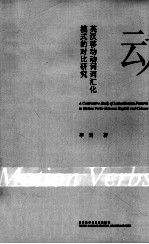
- 作 者:李雪著
- 出 版 社:北京:外语教学与研究出版社
- 出版年份:2011
- ISBN:9787513511971
- 标注页数:166 页
- PDF页数:128 页
请阅读订购服务说明与试读!
订购服务说明
1、本站所有的书默认都是PDF格式,该格式图书只能阅读和打印,不能再次编辑。
2、除分上下册或者多册的情况下,一般PDF页数一定要大于标注页数才建议下单购买。【本资源128 ≥166页】
图书下载及付费说明
1、所有的电子图书为PDF格式,支持电脑、手机、平板等各类电子设备阅读;可以任意拷贝文件到不同的阅读设备里进行阅读。
2、电子图书在提交订单后一般半小时内处理完成,最晚48小时内处理完成。(非工作日购买会延迟)
3、所有的电子图书都是原书直接扫描方式制作而成。
Chapter 1 Introduction 1
1.1 Significance of the Study 1
1.2 Theoretical Background 3
1.2.1 Cognitive Linguistics 3
1.2.2 Contrastive Linguistics 6
1.2.3 Linguistic Typology 7
1.3 Terminologies 8
1.3.1 Lexicalization and Lexicalization Patterns 9
1.3.2 Motion Events and Motion Verbs 13
1.4 Organization of the Book 15
Chapter 2 Literature Review 17
2.1 Introduction 17
2.2 Review of Formulations of Motion Events 18
2.2.1 Source-Path-Goal Formulation of Fillmore,Lakoff and Johnson 18
2.2.2 Talmy's Figure-Motion-Path-Ground Characterization 24
2.2.3 Accounts of Langacker and Jackendoff 27
2.3 Review of Research on Lexicalization Patterns of Motion Events and Motion Verbs 31
2.3.1 Talmy's Theory of Typology for Motion Verbs 31
2.3.1.1 Motion+Manner/Cause 31
2.3.1.2 Motion+Path 35
2.3.1.3 Motion+Figure 37
2.3.1.4 A Typology for Motion Verbs 38
2.3.2 Talmy's Typology for the Lexicalization Patterns of Motion Events 41
2.3.3 Other Related Studies and Problems Concerning Research in Chinese 43
2.4 Summary 47
Chapter 3 Research Questions and Methodology 50
3.1 Introduction 50
3.2 Major Types of Motion Verbs in English and Chinese 50
3.3 Basic Uses of Motion verbs in English and Chinese 53
3.4 Research Questions and Basic Hypotheses of the Present Study 56
3.5 Methodology and Data 59
3.6 Summary 62
Chapter 4 A Quantitative Study of Motion Verbs in English and Chinese 63
4.1 Introduction 64
4.2 A Quantitative Study of Motion Verbs in English and Chinese in Literal Use 64
4.2.1 Samples and Procedures 64
4.2.2 Results and Discussions 65
4.2.2.1 Frequency of Use of Manner and Path Verbs in English and Chinese 65
4.2.2.2 Diversity of Use of Manner and Path Verbs in English and Chinese 67
4.2.2.3 Frequency of Use of Alternative Manner Expressions in English and Chinese 70
4.3 A Quantitative Study of Motion Verbs in English and Chinese in Metaphorical Use 73
4.3.1 Conceptual Metaphor Theory and Metaphorical Motion 73
4.3.2 Samples and Procedures 75
4.3.3 Results and Discussions 75
4.3.3.1 Target Domains and Types of Mapping of Spatial Motion in English and Chinese 75
4.3.3.2 Frequency of Use of Manner and Path Verbs in English and Chinese 81
4.3.3.3 Diversity of Use of Manner and Path Verbs in English and Chinese 82
4.3.3.4 Use of Alternative Manner Expressions in English and Chinese 86
4.4 A Survey of Motion Verbs in English and Chinese Dictionaries 88
4.5 Summary 91
Chapter 5 A Contrastive Study of Manner Verbs Between English and Chinese 93
5.1 Introduction 93
5.2 Similarities in Manner Verbs Between English and Chinese 93
5.3 Differences in Manner Verbs Between English and Chinese 100
5.4 Summary 113
Chapter 6 A Contrastive Study of Path Verbs Between English and Chinese 115
6.1 Introduction 115
6.2 Path Verbs in English 115
6.3 Path Verbs in Chinese 116
6.3.1 Path Verbs as a Colloquial Lexicalization Pattern 117
6.3.2 Double Features of Chinese Path Verbs 118
6.3.3 Grammaticalization of Chinese Path Verbs 121
6.4 Implications for Conceptualization 129
6.5 Summary 132
Chapter 7 Typological Shift of Chinese Motion Verbs and Its Mechanism 134
7.1 Introduction 134
7.2 Different Characteristics in the Use of Motion Verbs Between English and Chinese 134
7.3 Typological Shift of Chinese Motion Verbs and Its Mechanism 136
7.4 Summary 139
Chapter 8 Concluding Remarks 141
8.1 Major Contributions of the Present Study 141
8.2 Implications for Translation 146
8.3 Limitations and Suggestions for Future Research 152
Bibliography 153
Appendix(Novels Used in the Quantitative Study of Motion Verbs) 163
后记 165
